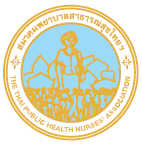Result of using triage guidelines for emergencies in the Outpatient Department, Chakkarat Hospital, Nakhon Ratchasima Province
Keywords:
Emergency Severity Index, Triage, Outpatient DepartmentAbstract
Triage of patients with incorrect severity assessment may adversely affect a patient's survival from delayed treatment. This quasi-experimental research aims to study and evaluate the use of the Emergency Severity Index and satisfaction of nurses towards the application of this Index in the Outpatient Department of Chakkarat Hospital, Nakhon Ratchasima Province. The study group consisted of 6 registered nurses who performed procedures in the Outpatient Department and 180 patients who received services at the Outpatient Department. Data were collected from May 2020 to June 2020. Data were collected using the Assessment Form on Compliance with the Emergency Severity Index and “MOPH” ED. Triage Guideline of the Ministry of Public Health, and Interview Form on Satisfaction. Content Validity was checked by IOC=0.86 and reliability was calculated by Cronbach’s alpha coefficient at 0.82. Data were represented using descriptive statistics and chi-square test.
The results revealed that 100% of registered nurses had applied the Emergency Severity Index and the efficiency of a correct emergency severity order was 98.9%. The correctness of medical triage performed by individual nurses was not different from the correctness of the Emergency Severity Index (c2=4.045, df=5, p=0.543). Overall satisfaction of registered nurses with the Emergency Severity Index was at a high level ( =4.46, S.D.=0.467). Findings showed that the Emergency Severity Index met nursing standards and the hospital could apply the Emergency Severity Index for efficient and timely treatment of Emergency Department patients.
References
Haruthai C, Leelawong S, Khansatapornkun K, editors. National Nursing Service Strategy 2017 - 2021 according to the 20-Year National Strategic Plan (Public Health). Nonthaburi: Nursing Division Ministry of Public Health 2018.
Jirasinthipok T, Jermwiwatnakul P, Nittayangkun S, Wongsuansiri S, Wongcharoen S, editors. Standards of Nursing Care. 2nd ed. Nonthaburi: Wvo Officer Of Printing Mill 2008.
Christ M, Goransson F, Winter D, Bingisser R, Platz E. Modern Triage in the Emergency Department. Medicine 2010; 107(50): 892-8.
Yurkova I, Wolf L. Under-triage as a significant factor affecting transfer time between the emergency department and the intensive unit. Journal of Emergency Nursing 2011; 37(5): 491-6.
Hoot N, Aronsky D. Systematic review of emergency department Crowding: Cause, effects, and solutions. Annuals of Emergency Medicine 2008; 53(2): 126-36.
Manangan M. Service Profile Outpatient department Chakkarat Hospital 2018. Nakhon Ratchasima: Chakkarat Hospital; 2018.
Setthasathien A. Guidelines for Emergency Medical Triage Protocol and Criteria Based Dispatch and Emergency Severity Index by the National Institute for Emergency Medicine. 3rd ed. Nonthaburi: National Institute for Emergency Medicine; 2015.
Cochran, W.G. Sampling technique. New York: John Wiley & Son. Inc; 1953.
Department of Medical Services. Services Ministry Of Public Health; 2018.
Sukswang S. Triage Nurse: Beyond Main Process Through Practice. Journal of Health Sciences Scholarship 2018; 5(2): 1-14. (in Thai)
Larthum K, Pearkao C. A Study of Quality of Emergency Patient Triage at Srinagarind Hospital. Khon Kaen: The National and International Graduate Research Conference; 2017.
Pimsung S. The Effect Of A Clinical Practice Guideline On Abdominal Pain Triage InOutpatients. Community Nurse Practitioner Faculty of Nursing Thammasat University; 2017.
Downloads
Published
How to Cite
Issue
Section
License
บทความที่ตีพิมพ์และแผนภูมิรูปภาพถือเป็นลิขสิทธิ์ของวารสารพยาบาลสาธารณสุข (Thai Public Health Nurses Association)






